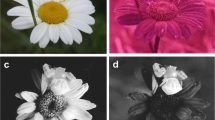Abstract
Masquerading prey closely resemble inedible objects found in the same locality. These animals gain protection from their predators by causing their predators to misclassify them as the inedible ‘models’ that they appear to resemble. We recently demonstrated that predators are more likely to misclassify masquerading prey as their models when masqueraders are viewed in isolation from their models than when they are viewed simultaneously with examples of their models. Using domestic chicks (Gallus gallus domesticus) as predators and the twig-mimicking caterpillars of the Early Thorn Moth (Selenia dentaria) as prey, we tested whether this effect was influenced by the relative orientations of models and masqueraders; and the distance from which models and masqueraders could be viewed simultaneously. We found no effect of orientation, but that the cost to masqueraders of being viewed simultaneously with an example of the model declined as the distance between the model and masquerader increased. These results are interpreted in terms of animal cognition, and their implications for the evolutionary ecology of masquerade.



Similar content being viewed by others
References
Allen JA, Cooper JM (1985) Crypsis and masquerade. J Biol Edu 19:268–270
Caro T (2005) Antipredator defences in birds and mammals. Chicago University Press, Chicago, pp 34–55
Cott HB (1940) Adaptive coloration in animals. Methuen, London
De Ruiter L (1952) Some experiments on the camouflage of stick caterpillars. Behaviour 4:222–232
Edmunds M (1974) Defence in animals: A survey of anti-predator defences. Longman, Harlowe
Endler JA (1981) An overview of the relationships between mimicry and crypsis. Biol J Linn Soc 16:25–31
Gilbert FRS (2005) The evolution of imperfect mimicry. In: Fellowes M, Holloway G, Rolff J (eds) Insect evolutionary ecology. CABI Publishing, Wallingford, pp 231–288
Greene E (1989) A diet-induced developmental polymorphism in a caterpillar. Science 243:643–646
Hailman JP (1977) Optical signals: animal communication and light. Indiana University Press, Bloomington, pp 174–176
Hamm J, Matheson WR, Honig WK (1997) Mental rotation in pigeons (Columba livia)? J Comp Psychol 111:76–81
Land MF, Nilsson D-E (2002) Animal eyes. Oxford University Press, Oxford
Mariath HA (1982) Experiments on the selection against different colour morphs of a twig caterpillar by insectivorous birds. Zeitschrift für Tierpsychologie 16:135–145
Nakagawa S (2004) A farewell to Bonferroni: the problems of low statistical power and publication bias. Behav Ecol 6:1044–1045
Pfennig DW, Harcombe WR, Pfennig KS (2001) Frequency-dependent Batesian mimicry. Nature 410:323
Porter J (1997) The colour identification guide to the caterpillars of the British Isles (Macrolepidoptera). Viking, London
Rashed A, Sherratt TN (2007) Mimicry in hoverflies (Diptera: Syrphidae): a field test of the competitive mimicry hypothesis. Behav Ecol 18:337–344
Ruxton GD, Beauchamp G (2008) Time for some a priori thinking about post hoc testing. Behav Ecol 19:690–693
Schmid KL, Wildsoet CF (1998) Assessment of visual acuity and contrast sensitivity in the chick using optokinetic nystagmus paradigm. Vis Res 38:2629–2634
Shepard RN, Metzler J (1971) Mental rotation of three-dimensional objects. Science 171:701–703
Skelhorn J, Ruxton GD (2010) Predators are less likely to misclassify masquerading prey when their models are present. Biol Lett 6:597–599
Skelhorn J, Ruxton GD (2011a) Context-dependent misclassification of masquerading prey. Evol Ecol 25:751–761
Skelhorn J, Ruxton GD (2011b) Mimicking multiple models: polyphenetic masqueraders gain additional benefits from crypsis. Behav Ecol 22:60–65
Skelhorn J, Ruxton GD (2013) Size-dependent microhabitat selection by masquerading prey. Behav Ecol 24:89–97
Skelhorn J, Rowland HM, Ruxton GD (2010a) The evolution and ecology of masquerade. Bio J Linn Soc 99:1–8
Skelhorn J, Rowland HM, Speed MP, Ruxton GD (2010b) Masquerade: camouflage without crypsis. Science 327:51
Skelhorn J, Rowland HM, Speed MP, De Wert L, Quinn L, Delf J, Ruxton GD (2010c) Size-dependent misclassification of masquerading prey. Behav Ecol 21:1344–1348
Skelhorn J, Rowland HM, Delf J, Speed MP, Ruxton GD (2011) Density-dependent predation influences the evolution and behaviour of masquerading prey. Proc Nat Acad Sci USA 108:6532–6536
Stevens M, Merilaita S (2009) Animal camouflage: current issues and new perspectives. Phil Trans Roy Soc B 364:423–427
Tinbergen L (1960) The natural control of insects in pinewoods. 1. Factors influencing the intensity of predation by a song bird. Arch Neerlandaises de Zoologie 13:265–343
Acknowledgments
We would like to thank Hannah Rowland, Jon Delf and Leoni de Wert for their help with obtaining and rearing caterpillars; and Candy Rowe for her useful comments on the manuscript. This work was funded by NERC Grant NE/E016626/1, and a start-up fund awarded to JS by the University of Exeter.
Author information
Authors and Affiliations
Corresponding author
Electronic supplementary material
Below is the link to the electronic supplementary material.
10682_2013_9683_MOESM1_ESM.tif
Supplementary material 1 (TIFF 16 kb) Figure S1 The mean and standard deviation of the latency to attack the branch in the first experience manipulation trial in Experiment1 (N = 10 for each experimental group)
10682_2013_9683_MOESM2_ESM.tif
Supplementary material 2 (TIFF 31 kb) Figure S2 The mean number of times that chicks pecked the branch in each of the four experience manipulation trials in Experiment 1 (N = 10 for each experimental group)
10682_2013_9683_MOESM3_ESM.tif
Supplementary material 3 (TIFF 20 kb) Figure S3 The mean and standard deviation of the latency to attack the branch in the first experience manipulation trial in Experiment 2 (N = 8 for each experimental group)
10682_2013_9683_MOESM4_ESM.tif
Supplementary material 4 (TIFF 33 kb) Figure S4 The mean number of times that chicks pecked the branch in each of the four experience manipulation trials in Experiment 2 (N = 8 for each experimental group)
Rights and permissions
About this article
Cite this article
Skelhorn, J., Ruxton, G.D. Viewing distance affects how the presence of inedible models influence the benefit of masquerade. Evol Ecol 28, 441–455 (2014). https://doi.org/10.1007/s10682-013-9683-6
Received:
Accepted:
Published:
Issue Date:
DOI: https://doi.org/10.1007/s10682-013-9683-6




